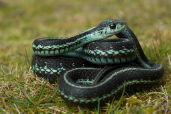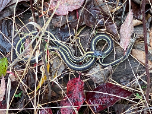Puget Sound Garter Snake (Thamnophis sirtalis pickeringii)
Description: The Puget Sound Gartersnake is dark grey to black with three yellow or bluish-grey stripes: one narrow stripe down the back (dorsal stripe) and one on each side (lateral stripes). The lateral stripes are confined to the second and third scale row. Unlike the other subspecies of the Common Gartersnake that occur in B.C., the red bars on the sides between the dorsal and side stripes are often very faint or absent. The Valley Gartersnake typically only has seven scales on the upper lip and has a yellowish chin and belly. Individuals can grow to just over a 3 feet in length.
Habitat: The Puget Sound Gartersnake is a habitat generalist and can be found in a wide variety of habitats, including forests, wetlands, shrublands, wetlands, shorelines, fields and rocky areas. This species also inhabits many urban and human-dominated landscapes. Puget Sound Gartersnakes are commonly found under cover objects, such as rocks and logs, which provide important microhabitat for shelter and thermoregulation. They overwinter — often communally — below the frost line in mammal burrows, rock crevices, crayfish burrows, anthropogenic structures (e.g. old foundations, cisterns), ant mounts and other underground cavities.
Range: This Puget Sound Gartersnake has a limited geographic distribution. It is restricted to Vancouver Island and the adjacent mainland coast in Canada and to Northwestern Washington.
Found in these States:
WA
Diet: The Puget Sound Gartersnake primarily forages during the day and eats a wide variety of prey, including frogs, toads, salamanders, earthworms, slugs, small fish, mice and occasionally birds and eggs.
Reproduction: Puget Sound Gartersnakes breed in the spring, soon after emerging from hibernation. Females typically give birth to 5–40 live young in July or August. The young are 13–23 cm in length at birth and mature in two or three years.
Status: We are researching the subspecies Status.
»» Kingdom: Animalia - Animals
»» Phylum: Chordata - Chordates
»» Subphylum: Vertebrata - Vertebrates
»» Class: Reptilia - Reptiles
»» Order: Squamata - Scaled Reptiles
»» Suborder: Serpentes
»» Superfamily: Colubroidea
»» Family: Colubridae - Colubrids
»» Genus: Thamnophis
»» Species: Thamnophis sirtalis - Common Garter Snake
»» Subspecies: Thamnophis sirtalis pickeringii - Puget Sound Garter Snake
This article uses material from the Wikipedia article "Common Garter Snake", which is released under the Creative Commons Attribution-Share-Alike License 3.0. Content may have been omitted from the original, but no content has been changed or extended.
|








